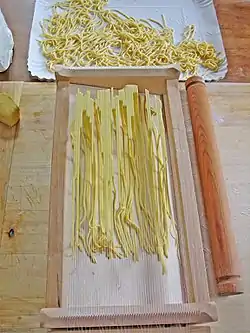Spaghetti alla chitarra
Spaghetti alla chitarra (Italian: [spaˈɡetti ˌalla kiˈtarra]), also known as maccheroni alla chitarra, is a variety of egg pasta typical of the Abruzzo region in Italy, with a square cross section about 2–3 mm thick. Tonnarelli are a similar pasta from Lazio.[1] Ciriole is the thicker version of chitarra, approximately double the thickness of spaghetti. It has a squared shape rather than round.
 Traditional preparation using chitarra | |
| Alternative names | Maccheroni alla chitarra |
|---|---|
| Type | Pasta |
| Place of origin | Italy |
| Region or state | Abruzzo |
| Main ingredients | Durum, egg, salt |
| Variations | Tonnarelli |
Origin of the name
The name of this spaghetti comes from the tool (the so-called chitarra, literally "guitar") this pasta is produced with, a tool which gives spaghetti its name, shape and a porous texture that allows pasta sauce to adhere well. The chitarra is a frame with a series of parallel wires crossing it.
History and production
The origin of the chitarra is still not very clear, a traditional recipe from the province of Teramo originated in the early 1800s or even before. Before then, pasta was cut with a special rolling pin with notches to obtain its particular shape.[2] Although its origins are from Abruzzo, you can find different versions and names in the southern part of Italy. It gets the name of Tonnarelli in Lazio, torchioli, troccoli o truoccoli in Basilicata & Puglia or Maccheroni Crioli in Molise.
The dough consists of durum wheat semolina and eggs (No salt). It is then worked and, after a rest of about 30 minutes covered, rolled flat with a rolling pin. The dough is then placed on the chitarra and pushed through with the rolling pin, so that the strings of the guitar cut it into strips.[3] Pasta makers from Abruzzo bring down the cut dough by passing their fingers on it, as they would "play a guitar".
In Abruzzo, maccheroni alla chitarra are most typically prepared with a ragu of pork, beef and lamb. In particular areas of the Abruzzi (for example Teramo) the traditional condiment is tomato sauce with beef meatballs, so-called pallottine.[4] In Abruzzo, chitarra alla teramana is a long thin squared spaghetti pasta served with tiny meatballs (polpettine).[5] It is a traditional Abruzzo recipe. It is generally a first course (primo piatto). The spaghetti is seasoned with meat or vegetable ragù and served with pallottine.
.jpg.webp)
A dried variation, without egg, is often marketed as spaghetti or maccheroni alla chitarra both within and outside Italy.[6][7]
See also
References
- "Tonnarelli is a local variation from Lazio". dececco.it. Retrieved 29 September 2014.
- "Spaghetti chitarra". pastagarofalo.it. Retrieved 29 September 2014.
- "Barilla". barilla.it. Retrieved 29 September 2014.
- "De Cecco: Maccheroni alla chitarra all'uovo". dececco.it.
- Italy Magazine, Abruzzo's Traditional Foods From Mountain to Sea, Rebecca Winke, Thursday, March 30, 2017
- "Spaghetti alla chitarra marketed outside of Italy". barilla.com.
- "Maccheroni alla chitarra (without egg) available in Italian supermarkets". dececco.it.
